Reel 23 seems to have been gone for a few years now, but I thought I would do a write up of one of their releases anyway: Time and Matter, the collection of films by Mika Taanila.
All of the five films seem concerned with visions of the future or experiments to progress technological advancement. However at the same time there seems to be a strange nostalgia about past visions of the future – over optimistic visions of the world of tomorrow from architects and artists and footage of experiments where the reason for performing them and their scientific purpose has been lost, leaving just strange images or obsolete relics behind.
Robocup ‘99 (2000)
Robocup ‘99 is perhaps the most accessible film of the DVD, showcasing a sort of scientific version of Robot Wars in which Universities battle teams of robot players (in different leagues from four legged to humanoid, and from totally controlled by a master computer to autonomous and separate from the other players on their team). While the concepts behind this challenge are interesting – to develop robots that can react to new challenges on their own, and then work collaboratively towards a common goal, without having to be programmed with every possible possibility they might encounter – there is a slight air of scientists goofing around! There is the stated ambition, rather laughably suggested as correlating to the race to the Moon, that by 2050 a robot team will have been developed that will beat a human team in a game of football by FIFA rules. While this is suggested as having great implications for robotics and a leap forward similar to that of Deep Blue beating Gary Kasparov in chess, it also has a less noble ring of non-sporty nerds wanting to finally beat the jocks at literally their own game!
(Though it might have real world applications after all - with the prices football clubs seem to pay for players perhaps it would be quicker and cheaper to build your own. Sure it would turn football into something akin to Formula 1, but at least there wouldn’t be situations where players are found getting drunk and assaulting people in nightclubs, or having their orgy sex tapes revealed by the tabloids! Sure there would probably be a few homicidal rampages by haywire robots (leading to reams of tabloid speculation about “whether the machine gun and stabbing mechanisms were really necessary additions to a robot created for a ball game?”), but surely that would be a small price to pay to remove the overpriced and already malfunctioning human element from the game? ) However, the
2007 humanoid robot final does seem to be showing some movement towards that 2050 goal!
Perhaps this unintellectual approach to the tournament is more the fault of Taanila’s film, which treats the Robocup as a real, emotionally involving, competition. Or perhaps it is also the fault of the scientists getting too involved in their robots winning their tournament rather than learning anything in particular from the matches (there is a telling moment where one person in challenging a decision on the rules of the Robocup match that her team lost because of the colour of the pitch causing recognition problems for the robots
both seems to be acting like a sore loser trying to challenge the ref, yet at the same time the reactions of everyone to her queries seems to suggest that the ‘game’ is taking precedence over the ‘science’). On the other hand, perhaps this shows the difficult relationship between science and art: between purely clinical and detached science and the increasing need to ‘involve the public’ in scientific matters by ‘sexing up’ their material and making robots play football in order to engage a wider audience?
Or perhaps it is just that football is kind of a common denominator that all the Universities taking part in the tournament, from Japan to Argentina, can understand the rules of and create their robots to play?
Anyway if you don’t want to know the results of the film's big final match, look away now:
The Iranian team win 3-1 against the Italians in the final of the Middle Size Robot League.Other results
here. Iran came third the next year in Melbourne
Far more ‘fly on the wall’ handheld than the other documentaries on the disc the film also has a rather wearying computer voice handling the narration duties, though I suppose it could have been more difficult to follow than it turned out to be.
Here’s the official RoboCup site.
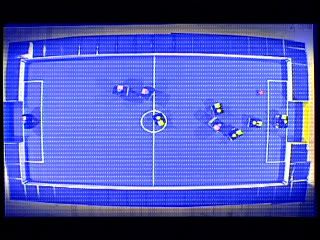 The Future Is Not What It Used To Be
The Future Is Not What It Used To Be (2002)
A profile of Finnish electronic musician/filmmaker/computer programmer Erkki Kurenniemi, this film takes us on a classical journey through his life and work, his interest in filmmaking leading to a fascination with electronic music. A lot of his work in that area seemed about capturing physical movement in sound form, such as in an extract from dance films and a version of Beckett using parts of the image that are revealed and hidden to create the music. As Kurenniemi, prone to philosophising, says near the beginning of the film, the distinction between ‘body’ and ‘soul’ is similar to that between ‘hardware’ and ‘software’. The creation of the various versions of the DIMI machine move from physical machines being programmed to reproduce complex combinations of sound – an early synthesiser – to types of machines that translate physical movements into sound, a slightly different way of programming and playing electronic music.
This is another film about art and science co-existing, or of trying to find the art inherent in science. One of the most interesting aspects of the film itself is that it is a biography looking back on a life but that life was concerned with futuristic developments, so there is an interesting contrast between 60s and 70s futurism and modern life where technology has moved on but is not as visible any more. The punched tape and electronic music have given way to digital cameras and hard disk storage, less futuristic seeming on first glance, but far more advanced.
The later aspects of the film focus on the Kurrenemi’s use of technology as a way of recording the present for the future and the different 'feelings' between photo, video and audio captures of an event. There is also the rather strange notion that by collecting every mundane detail of a life in diary form, down to receipts, that a life can be recreated (I’m not sure if I would agree that simply taking everything a person says and does and what they buy really gets to the essence of a person’s existence and consciousness, though I’m sure the data will be useful for governments and corporations to create a profile of a person’s tastes and proclivities!)
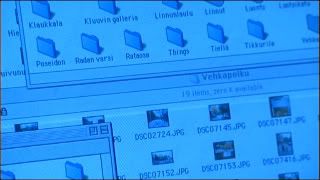 Futuro – A New Stance For Tomorrow
Futuro – A New Stance For Tomorrow (1998)
A film on the creation and marketing of the
Futuro House, again another example of ‘dated futurism’. There was a lot of talk in the film about problems in exhibiting and marketing the house properly and it was interesting to wonder about why houses are built in a certain uniform boxy shape rather than in circles or ovals, but I suppose if you are looking to store items or create spaces for kitchen units etc it would be more practical to maximise the available space with straight walls and uncurved surfaces. Also I guess by the way everyone in the film is stooped over, if you are taller than average height you’ll be constantly banging your head on parts of the structure! There is also the amusing sequence where a cat is put inside the house (because a cat always finds the best place to curl up) and goes crazy trying to find a corner to sit in! So architecture could be considered to be as much psychologically influenced as art or commerce based.
After the house itself proved to be an impractical commercial prospect it gets used for more arty, esoteric purposes: porn magazines do sexy Barbarella-style photo shoots in it; Christo wraps it up; Warhol visits, and so on. It literally becomes a UFO in its purpose because that is what people made of it, not a house but a curiosity that it would be interesting to visit and briefly look inside.
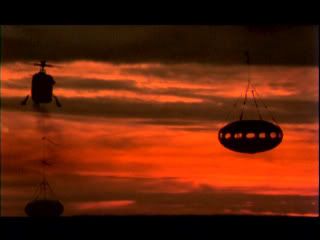 A Physical Ring
A Physical Ring
A real curiosity in that this film is found footage of a vibrating ring seemingly responding to the rotation of a machine inside the circle. According to the notes it is just described as “A Physical Ring. Finland. 1940s”. What is the experiment about? Is it about rotation causing fluctuations inside the Earth, say the rotation of the core and its affects on surface features such as tides? Or is it just something of no significance whatsoever? Either way the ring moving back and forth, restarted a couple of times at different speeds, along with the electronic music layered over the top creates a rather hypnotic effect even before we reach the epilepsy-inducing flash frames until the film burns in-camera.
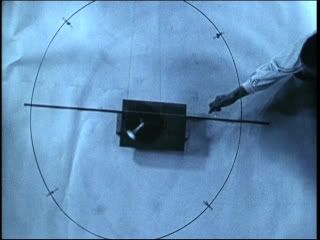 Optical Sound
Optical Sound (2005)
The highlight of the disc would have to be this music video created by defunct dot matrix printers! I described above how it could be a love it or hate it piece but I really liked the intricate editing of the video and repurposing of ‘useless’ or superceded technology into something artistically relevant.
The commentary by the artists [The User] over this highlights a number of interesting themes, such as reversing the usual use of printers by typing in, or programming, illegible characters and laying them out in a particular way so that when they are printed they create not a finished document but a particular sound. I guess, not being musical myself, that it is similar to how any musical instrument is ‘programmed’, but just more emphasised in the way that this was not the originally intended purpose for the equipment.
In fact that is one of the stated intentions of the piece, to take equipment intended for a practical, non-artistic purpose and showing that it too can be used to create something interesting. The commentary states that it is also sort of the background noise to office life – instead of workers toiling in other ‘aggressively industrial’ environments such as cotton mills (which I hear had similarly hypnotic and mechanical routines that could lull workers into making disastrous mistakes) people now mostly tend machines that keep the information society going, and similarly work at the pace that is dictated by the machine.
It’s a wonderful piece and will certainly make my Shorts List if we do another one of those. (Mistabishi’s recent “Printer Jam” is sort of the dance music version of a similar concept) I’m trying to decide whether it might even make it onto my 2000s list as well.
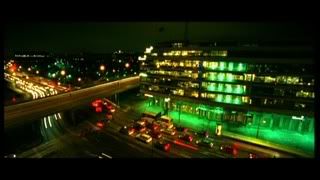
Overall the Reel 23 set is a nice package. It looks as if
Futuro has been released separately since along with a book on the house and Taanila’s earlier film Thank You For The Music (all about Muzak) is not on the disc but there are commentaries on Optical Sound and Future Is Not What It Used To Be, which are fascinating additions in themselves.




